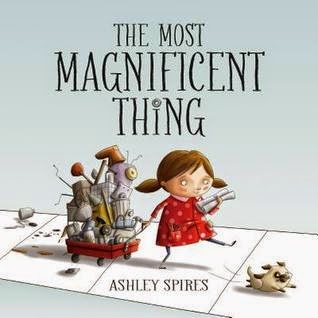I really
admired the unique way the illustrator told the story along with the author in
this picture book. I’m so glad I was introduced to this story through the
nominations for the Blue Spruce Award and my school librarian. It’s really a
picture book for all ages, not just children.
Here's
the summary from Amazon:
This
gorgeous picture book is based on the true story of Joshua Bell, the renowned
American violinist who famously took his instrument down into the Washington
D.C. subway for a free concert. More than a thousand commuters rushed by him,
but only seven stopped to listen for more than a minute.
In The Man With the Violin, bestselling
author Kathy Stinson has woven a heart-warming story that reminds us all to
stop and appreciate the beauty that surrounds us.
Dylan is
someone who notices things. His mom is someone who doesn't. So try as he might,
Dylan can't get his mom to listen to the man playing the violin in the subway
station. But Dylan is swept away by the soaring and swooping notes that fill
the air as crowds of oblivious people rush by. With the beautiful music in his
head all day long, Dylan can't forget the violinist, and finally succeeds in making
his mother stop and listen, too.
Vividly
imagined text combined with illustrations that pulse with energy and movement
expertly demonstrate the transformative power of music. With an afterword
explaining Joshua Bell's story, and a postscript by Joshua Bell himself.
The Man With the Violin, written by Kathy Stinson and illustrated by
Dusan Petricic, was first published by Annick Press, Toronto in 2013.
My
thoughts as a writer:
The
opening line drew me right in. I could tell this was going to be a meaningful story.
One of the lovely aspects of this story is that although there’s an underlying message
about “paying attention” and it lingers with you after reading, it is never
once mentioned in the text.
The language
of the story really captures the contrast of the noisy subway and the lyrical
music, but it’s really the partnership of the text and illustrations that make
this book so successful. Through the creative use of colour and line, the
illustrator brings out the contrast between the bustle of the subway and the
peaceful moments in the music.
My
thoughts as a teacher:
This is
a story that may need some discussion during or after reading. I really liked
the notes about Joshua Bell and the Postscript written by Joshua Bell. It’s
wonderful to have the itunes link included to be able to actually play the
music from the story. There is a lot to talk about in the illustrations, and
especially about how the illustrator uses line and colour.
Although
the age-range for this book is listed as 5-8, older students might also
appreciate the meaning behind this book. They might also think about the
different ways the author used words to convey different feelings and sounds.
Themes: creativity, culture, appreciating the
world around you
Ages: 5 –
8
Grades:
K - 3
Possible activities for students:
- create
art using line and colour while listening to different types of music
- talk
or write about a time that they noticed something interesting that others
overlooked
- watch
this video about the story behind the book with the author and the illustrator
-
discuss this quote from author Kathy Stinson: “The world’s not a bad place if we pay
attention a little bit more.”
If you're looking for more great picture books to read to your class or to investigate as a writer, consider checking out the list of Perfect Picture Books, put together by author Susanna Leonard Hill.






